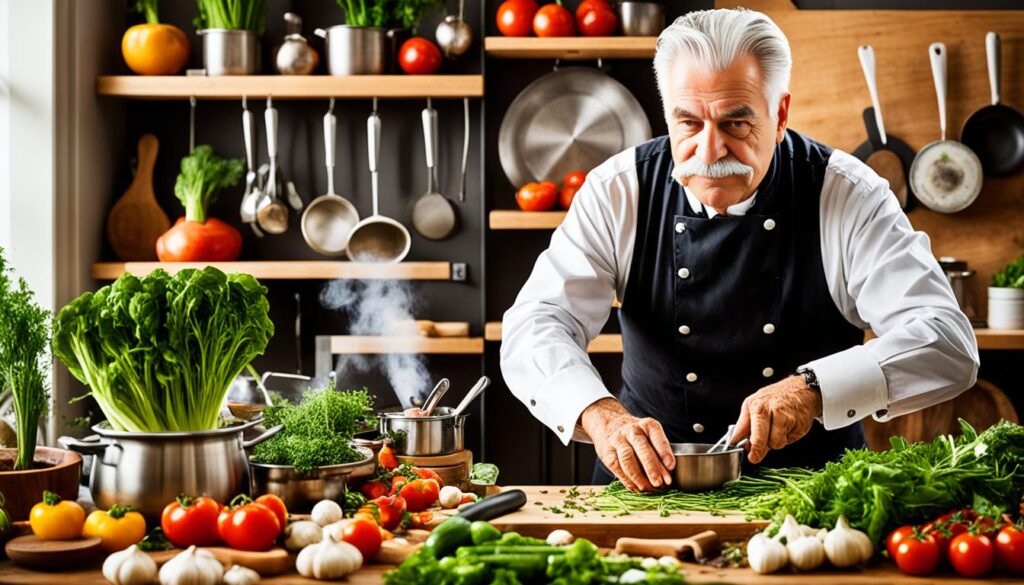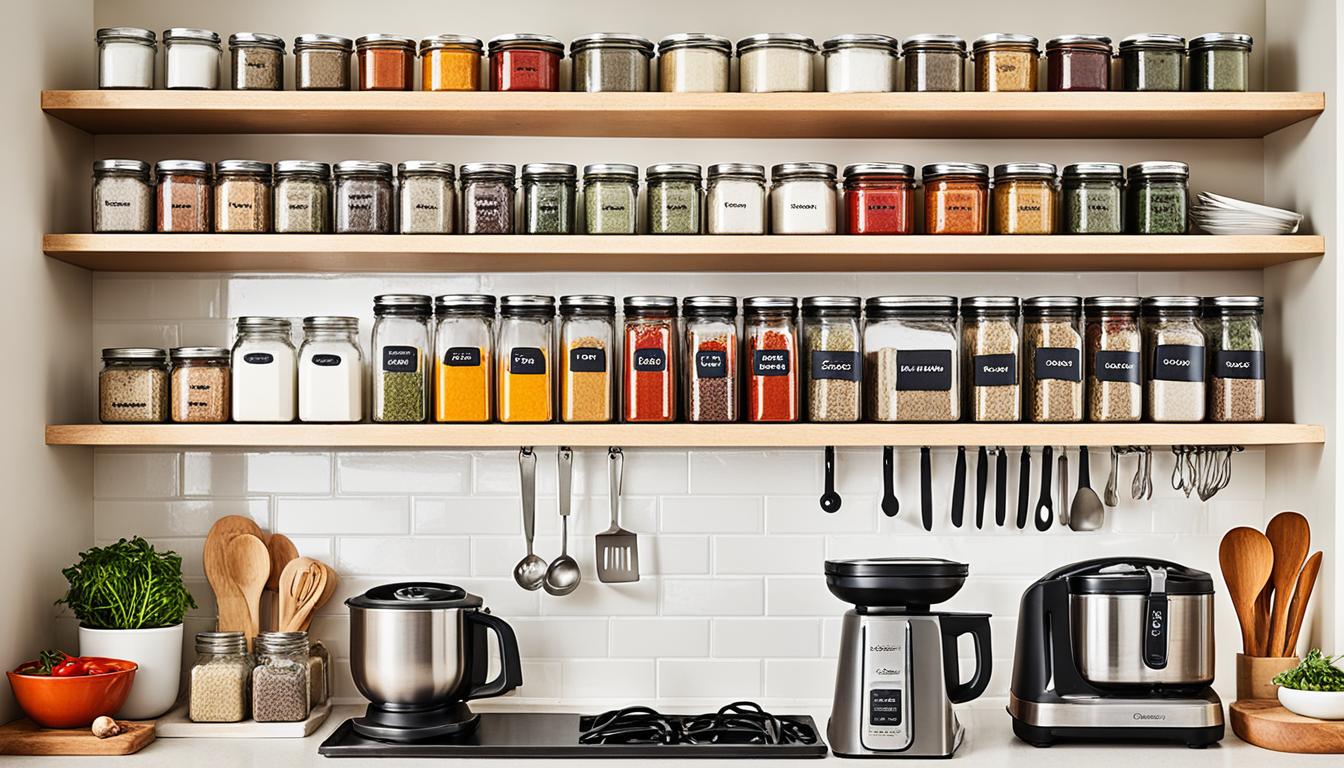Are you tired of feeling overwhelmed in the kitchen? Do you wish there was a way to streamline your cooking process and make it more efficient? Look no further than the practice of mise en place. Whether you’re a professional chef or a home cook, mastering mise en place can revolutionize your culinary preparation and cooking experience.
Mise en place, which translates to “everything in its place,” is a technique used by professional chefs around the world to ensure kitchen organization, efficiency, and success. By taking the time to organize your ingredients, tools, and workspace before you start cooking, you set yourself up for a seamless and stress-free culinary journey.
In this comprehensive guide, we will explore the benefits of mise en place and equip you with essential organization tips and techniques. Prepare to discover how professional chefs maintain their kitchen efficiency, learn time-saving strategies, and elevate their culinary skills to new heights.
Key Takeaways:
- Mise en place is a technique that ensures efficiency and success in the kitchen.
- It involves organizing your ingredients, tools, and workspace before cooking.
- Mastering mise en place can save you time, reduce stress, and elevate your culinary skills.
- Professional chefs rely on mise en place for efficient food service.
- Implementing mise en place involves strategies like meal prepping and clean as you go.
What is Mise en Place and How to Practice It
Mise en place, a French term meaning “everything in its place,” is a fundamental practice in the culinary world. It involves preparing and organizing your workspace and ingredients before you begin cooking. By following a few crucial steps, you can ensure that everything is ready to go when it’s time to cook, saving you time and minimizing stress.
The Steps to Mise en Place
- Check the recipe: Start by carefully reading and understanding the recipe you’ll be following. Take note of the ingredients, measurements, and any special instructions. This will help you gather everything you need and avoid last-minute surprises.
- Gather ingredients: Once you know what’s required, gather and measure all the necessary ingredients. This includes vegetables, meats, spices, and any other components mentioned in the recipe. Having everything prepped and ready to go will streamline your cooking process.
- Collect tools: In addition to ingredients, gather all the tools and utensils you’ll need during cooking. This could include pots, pans, knives, cutting boards, measuring cups, and spoons. Having all your tools within reach will save you time and prevent interruptions during the cooking process.
By following these steps, you can practice mise en place and ensure that you’re well-prepared for any cooking endeavor. This careful preparation is essential for a smooth and efficient culinary experience.
“Mise en place is the foundation of successful cooking. It allows the chef to focus on the actual cooking process without the distraction of searching for ingredients or tools.” – Chef Julia Child
When you practice mise en place, you’ll notice a significant improvement in your cooking efficiency. You’ll be able to dive into recipes confidently, knowing that you have everything organized and ready to go. Take the time to implement this practice in your kitchen, and you’ll see the difference it makes!
Now that we understand the importance of mise en place and how to practice it, let’s move on to exploring the history and significance of this culinary technique.
| Mise en Place Benefits | Mise en Place Tips |
|---|---|
| 1. Organized workspace | 1. Start with a clean and clutter-free workspace. |
| 2. Streamlined cooking process | 2. Chop, slice, and measure ingredients ahead of time. |
| 3. Improved time management | 3. Use small bowls or ramekins to hold pre-measured ingredients. |
| 4. Reduced stress | 4. Label containers or bags for easy identification. |
Implementing mise en place in your kitchen can revolutionize the way you cook, making the entire process smoother and more enjoyable. So let’s dive into the history and importance of mise en place in the culinary world.
The History and Importance of Mise en Place
Mise en place, a fundamental technique in the culinary world, has a rich history that dates back to the 19th century. This practice was developed by the renowned French chef Auguste Escoffier, who revolutionized the culinary industry with his emphasis on efficiency and organization.
Initially, mise en place was met with resistance as it disrupted traditional kitchen workflows. However, its importance quickly became apparent as it significantly improved kitchen efficiency and service quality. Chefs and cooks worldwide embraced the practice, recognizing its ability to streamline the cooking process and elevate the overall culinary experience.
Mise en place is not just about organizing ingredients and tools; it encompasses a complete approach to kitchen organization. By carefully planning and arranging every aspect of the cooking process, from prep work to plating, chefs ensure that each dish is promptly and perfectly composed.
The benefits of mise en place extend beyond efficient kitchen workflow. It also enhances service efficiency, allowing chefs and their teams to deliver exceptional dining experiences. By having all the necessary components in place, chefs can focus on the artistic aspect of plating and presentation, resulting in visually stunning dishes that delight both the eyes and palate.
Auguste Escoffier: Revolutionizing Kitchen Organization
Auguste Escoffier, often referred to as the “King of Chefs” and the “Chef of Kings,” played a pivotal role in popularizing mise en place. As a visionary culinary artist, Escoffier understood the importance of meticulous kitchen organization and efficiency.
Escoffier’s contributions to the culinary world extended far beyond the development of mise en place. He established a standardized system for kitchen operations, refined cooking techniques, and introduced various innovations that revolutionized professional kitchens. His legacy continues to shape the culinary industry to this day.

By embracing the principles of mise en place, aspiring chefs and culinary enthusiasts can elevate their cooking skills and become invaluable members of any culinary team. The practice enhances kitchen efficiency, organization, and service effectiveness, enabling individuals to navigate the demanding world of cooking with finesse and precision. Whether you’re an aspiring chef or a passionate home cook, understanding and implementing mise en place is the key to achieving culinary excellence.
Implementing Mise en Place in Your Kitchen
Implementing mise en place in your own kitchen involves various strategies and techniques that can greatly enhance your cooking experience. By adopting these practices, you can streamline your workflow, save time, and ensure that everything is organized and ready to go when it’s time to cook.
Meal Prep: The Key to Efficiency
Meal prep is a fundamental component of mise en place that allows you to prepare your ingredients ahead of time. By washing, chopping, and portioning your ingredients in advance, you can eliminate last-minute tasks and reduce the chances of missing any crucial steps in the recipe. This not only saves time but also ensures that your cooking process is smooth and stress-free.
Kitchen Organization: Arranging Your Workspace
Proper kitchen organization is essential for creating an efficient cooking environment. Take the time to arrange your workspace in a way that maximizes functionality and accessibility. Keep frequently used items within reach and group similar items together for easy access. This will minimize the time spent searching for utensils, spices, or other essentials, allowing you to focus on the cooking process.
Ingredient Preparation: Following Recipe Guidelines
Another crucial aspect of mise en place is preparing your ingredients as directed by the recipe. This means carefully reading and understanding the recipe instructions and ensuring that you have all the necessary ingredients measured, chopped, or prepped beforehand. By doing so, you avoid the need for frantic chopping or measuring during the cooking process, allowing you to stay organized and maintain a steady flow.
Clean as You Go: Promoting Efficiency
Maintaining a clean workspace is essential for an efficient cooking experience. Incorporate the “clean as you go” principle into your mise en place routine. This means tidying up and washing dishes, utensils, and countertops as you progress through the recipe. By doing so, you prevent clutter from building up and create a more organized and productive environment.
Implementing these strategies and techniques in your kitchen will vastly improve your cooking experience, whether you’re a professional chef or a home cook. By practicing meal prep, kitchen organization, ingredient preparation, and clean as you go, you’ll streamline your cooking process, save time, and enjoy a more efficient and enjoyable culinary journey.
| Mise en Place Techniques | Benefits |
|---|---|
| Meal prep | Streamlines cooking process |
| Kitchen organization | Enhances accessibility and functionality |
| Ingredient preparation | Minimizes last-minute tasks |
| Clean as you go | Promotes a clean and organized workspace |
Conclusion
Mastering the technique of mise en place is the secret ingredient to achieving kitchen efficiency and enhancing your culinary experience. By implementing proper organization, ingredient preparation, and practicing the clean as you go method, you can save valuable time and reduce stress in the kitchen. Whether you’re a professional chef or a home cook, incorporating mise en place into your cooking routine is essential for maximizing efficiency and culinary success.
With mise en place, you can say goodbye to frantic searches for ingredients and utensils during the cooking process. Everything will be neatly organized and readily available, allowing you to focus on the art of culinary preparation. This strategic approach not only saves time, but it also enhances the overall quality and presentation of your dishes.
By adopting time-saving strategies like meal prep and maintaining a clean workspace, you can streamline your cooking process and become more productive. Additionally, practicing mise en place cultivates a sense of discipline and precision, transforming you into a more confident and efficient cook.
So, let’s embrace mise en place in our kitchens and enjoy the benefits of a well-organized and seamlessly efficient cooking process. Whether it’s for a weeknight family meal or a special occasion, implementing mise en place will elevate your culinary skills and take your dishes to new heights.
